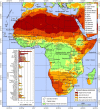Vector-borne disease and climate change adaptation in African dryland social-ecological systems
- PMID: 31130141
- PMCID: PMC6535848
- DOI: 10.1186/s40249-019-0539-3
Vector-borne disease and climate change adaptation in African dryland social-ecological systems
Abstract
Background: Drylands, which are among the biosphere's most naturally limiting and environmentally variable ecosystems, constitute three-quarters of the African continent. As a result, environmental sustainability and human development along with vector-borne disease (VBD) control historically have been especially challenging in Africa, particularly in the sub-Saharan and Sahelian drylands. Here, the VBD burden, food insecurity, environmental degradation, and social vulnerability are particularly severe. Changing climate can exacerbate the legion of environmental health threats in Africa, the social dimensions of which are now part of the international development agenda. Accordingly, the need to better understand the dynamics and complex coupling of populations and environments as exemplified by drylands is increasingly recognized as critical to the design of more sustainable interventions.
Main body: This scoping review examines the challenge of vector-borne disease control in drylands with a focus on Africa, and the dramatic, ongoing environmental and social changes taking place. Dryland societies persisted and even flourished in the past despite changing climates, extreme and unpredictable weather, and marginal conditions for agriculture. Yet intrusive forces largely out of the control of traditional dryland societies, along with the negative impacts of globalization, have contributed to the erosion of dryland's cultural and natural resources. This has led to the loss of resilience underlying the adaptive capacity formerly widely exhibited among dryland societies. A growing body of evidence from studies of environmental and natural resource management demonstrates how, in light of dryland system's inherent complexity, these factors and top-down interventions can impede sustainable development and vector-borne disease control. Strengthening adaptive capacity through community-based, participatory methods that build on local knowledge and are tailored to local ecological conditions, hold the best promise of reversing current trends.
Conclusions: A significant opportunity exists to simultaneously address the increasing threat of vector-borne diseases and climate change through methods aimed at strengthening adaptive capacity. The integrative framework and methods based on social-ecological systems and resilience theory offers a novel set of tools that allow multiple threats and sources of vulnerability to be addressed in combination. Integration of recent advances in vector borne disease ecology and wider deployment of these tools could help reverse the negative social and environmental trends currently seen in African drylands.
Keywords: Adaptive vector borne disease management; Biodiversity; Climate change adaptation; Complexity; Integrated vector management; Resilience; Social-ecological system; Traditional knowledge; Vector-borne diseases.
Conflict of interest statement
The authors declare that they have no competing interests.
Figures



Similar articles
-
The 2023 Latin America report of the Lancet Countdown on health and climate change: the imperative for health-centred climate-resilient development.Lancet Reg Health Am. 2024 Apr 23;33:100746. doi: 10.1016/j.lana.2024.100746. eCollection 2024 May. Lancet Reg Health Am. 2024. PMID: 38800647 Free PMC article. Review.
-
Navigating challenges and opportunities of land degradation and sustainable livelihood development in dryland social-ecological systems: a case study from Mexico.Philos Trans R Soc Lond B Biol Sci. 2012 Nov 19;367(1606):3158-77. doi: 10.1098/rstb.2011.0349. Philos Trans R Soc Lond B Biol Sci. 2012. PMID: 23045713 Free PMC article.
-
Addressing vulnerability, building resilience: community-based adaptation to vector-borne diseases in the context of global change.Infect Dis Poverty. 2017 Dec 11;6(1):166. doi: 10.1186/s40249-017-0375-2. Infect Dis Poverty. 2017. PMID: 29228986 Free PMC article. Review.
-
Support for research towards understanding the population health vulnerabilities to vector-borne diseases: increasing resilience under climate change conditions in Africa.Infect Dis Poverty. 2017 Dec 12;6(1):164. doi: 10.1186/s40249-017-0378-z. Infect Dis Poverty. 2017. PMID: 29228976 Free PMC article.
-
Restoring Food Systems with Nutritious Native Plants: Experiences from the African Drylands.Food Nutr Bull. 2023 Dec;44(2_suppl):S58-S68. doi: 10.1177/03795721231190779. Food Nutr Bull. 2023. PMID: 37850924
Cited by
-
Implications of global environmental change for the burden of snakebite.Toxicon X. 2021 Jun 18;9-10:100069. doi: 10.1016/j.toxcx.2021.100069. eCollection 2021 Jul. Toxicon X. 2021. PMID: 34258577 Free PMC article.
-
Impact of Climate Change on the Global Dynamics of Vector-Borne Infectious Diseases: A Narrative Review.Cureus. 2025 Jan 25;17(1):e77972. doi: 10.7759/cureus.77972. eCollection 2025 Jan. Cureus. 2025. PMID: 39996198 Free PMC article. Review.
-
Interactive effects of biological, human and environmental factors on tick loads in Boran cattle in tropical drylands.Parasit Vectors. 2021 Apr 6;14(1):188. doi: 10.1186/s13071-021-04683-9. Parasit Vectors. 2021. PMID: 33823921 Free PMC article.
-
One Health in Agricultural Sectors in Thailand, Lao PDR, and Vietnam: Interconnectedness Between Awareness and Socioeconomic Factors.Int J Public Health. 2024 Nov 28;69:1607088. doi: 10.3389/ijph.2024.1607088. eCollection 2024. Int J Public Health. 2024. PMID: 39670174 Free PMC article.
-
Biological Mechanisms for Allen's Rule: DNA Methylation as Mediator of the Association Between In Utero Exposure to Environmental Heat and Tibial Growth in Childhood.Am J Hum Biol. 2025 Jul;37(7):e70086. doi: 10.1002/ajhb.70086. Am J Hum Biol. 2025. PMID: 40605395 Free PMC article.
References
-
- UNDP, Editor. Human development for everyone. New York, NY: United Nations Development Programme; 2016.
-
- Prăvălie R. Drylands extent and environmental issues. A global approach. Earth-Sci Rev. 2016;161:259–278. doi: 10.1016/j.earscirev.2016.08.003. - DOI
-
- Abdelgalil EA. Deforestation in the drylands of Africa: quantitative modelling approach. Environ Dev Sustain. 2005;6:415–427. doi: 10.1007/s10668-005-0787-1. - DOI
-
- Sternberg T. Water megaprojects in deserts and drylands. Int J Water Resour Dev. 2016;32:301–320. doi: 10.1080/07900627.2015.1012660. - DOI
Publication types
MeSH terms
Grants and funding
LinkOut - more resources
Full Text Sources
Medical
Research Materials
Miscellaneous

